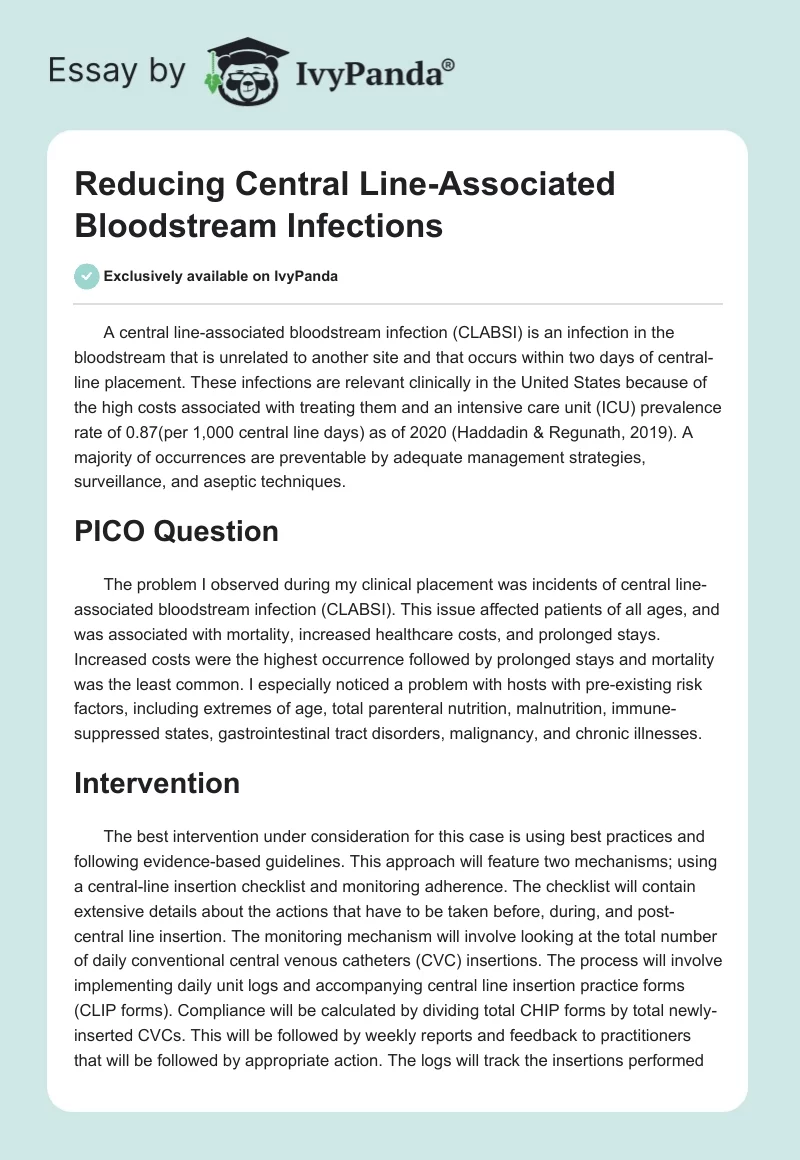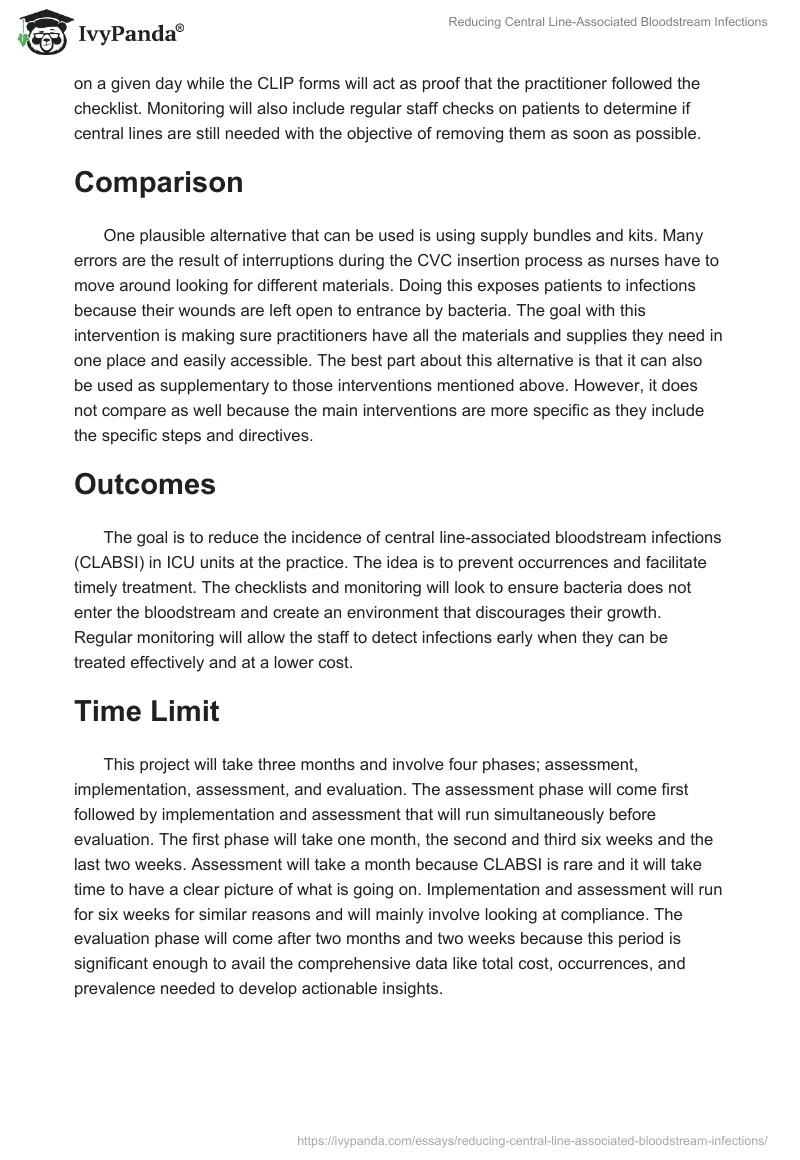A central line-associated bloodstream infection (CLABSI) is an infection in the bloodstream that is unrelated to another site and that occurs within two days of central-line placement. These infections are relevant clinically in the United States because of the high costs associated with treating them and an intensive care unit (ICU) prevalence rate of 0.87(per 1,000 central line days) as of 2020 (Haddadin & Regunath, 2019). A majority of occurrences are preventable by adequate management strategies, surveillance, and aseptic techniques.
PICO Question
The problem I observed during my clinical placement was incidents of central line-associated bloodstream infection (CLABSI). This issue affected patients of all ages, and was associated with mortality, increased healthcare costs, and prolonged stays. Increased costs were the highest occurrence followed by prolonged stays and mortality was the least common. I especially noticed a problem with hosts with pre-existing risk factors, including extremes of age, total parenteral nutrition, malnutrition, immune-suppressed states, gastrointestinal tract disorders, malignancy, and chronic illnesses.
Intervention
The best intervention under consideration for this case is using best practices and following evidence-based guidelines. This approach will feature two mechanisms; using a central-line insertion checklist and monitoring adherence. The checklist will contain extensive details about the actions that have to be taken before, during, and post-central line insertion. The monitoring mechanism will involve looking at the total number of daily conventional central venous catheters (CVC) insertions. The process will involve implementing daily unit logs and accompanying central line insertion practice forms (CLIP forms). Compliance will be calculated by dividing total CHIP forms by total newly-inserted CVCs. This will be followed by weekly reports and feedback to practitioners that will be followed by appropriate action. The logs will track the insertions performed on a given day while the CLIP forms will act as proof that the practitioner followed the checklist. Monitoring will also include regular staff checks on patients to determine if central lines are still needed with the objective of removing them as soon as possible.
Comparison
One plausible alternative that can be used is using supply bundles and kits. Many errors are the result of interruptions during the CVC insertion process as nurses have to move around looking for different materials. Doing this exposes patients to infections because their wounds are left open to entrance by bacteria. The goal with this intervention is making sure practitioners have all the materials and supplies they need in one place and easily accessible. The best part about this alternative is that it can also be used as supplementary to those interventions mentioned above. However, it does not compare as well because the main interventions are more specific as they include the specific steps and directives.
Outcomes
The goal is to reduce the incidence of central line-associated bloodstream infections (CLABSI) in ICU units at the practice. The idea is to prevent occurrences and facilitate timely treatment. The checklists and monitoring will look to ensure bacteria does not enter the bloodstream and create an environment that discourages their growth. Regular monitoring will allow the staff to detect infections early when they can be treated effectively and at a lower cost.
Time Limit
This project will take three months and involve four phases; assessment, implementation, assessment, and evaluation. The assessment phase will come first followed by implementation and assessment that will run simultaneously before evaluation. The first phase will take one month, the second and third six weeks and the last two weeks. Assessment will take a month because CLABSI is rare and it will take time to have a clear picture of what is going on. Implementation and assessment will run for six weeks for similar reasons and will mainly involve looking at compliance. The evaluation phase will come after two months and two weeks because this period is significant enough to avail the comprehensive data like total cost, occurrences, and prevalence needed to develop actionable insights.
Review of Literature
A substantial amount of research has gone into how to minimize central line-associated bloodstream infections (CLABSI). Patel et al. (2018) conducted a systematic review for the most used interventions and found that the most effective ones addressed multiple stages and involved auditing and feedback processes. Wichmann et al. (2018) found that checklists met that criteria and were effective in reducing CLABSI frequency. Other studies have identified other alternatives to reducing CLABSI incidences. For instance, using antiseptic barrier caps is also effective in lowering the rate (Voor et al., 2017). Other studies found evidence that supports the alternative intervention identified above. Payne et al. (2017) reviewed literature on the efficacy of using care bundles in reducing the CLABSI incidents in neonatal ICUs and found they reduced occurrences significantly.
The problem under consideration is incidents of central line-associated bloodstream infections (CLABSI) in the ICU. These infections are associated with prolonged hospital stays, increased health care costs, and mortalities. The suggested interventions are using a central-line insertion checklist and monitoring adherence. An alternative would be using supply bundles and kits to make materials easy to access. The goal is to reduce the number and severity of incidents. Research shows that the best interventions are compound and include auditing and feedback.
References
Haddadin, Y., & Regunath, H. (2019). Central line associated blood stream infections (CLABSI). Nih.gov; StatPearls Publishing.
Patel, P. K., Gupta, A., Vaughn, V. M., Mann, J. D., Ameling, J. M., & Meddings, J. (2018). Review of strategies to reduce central line‐associated bloodstream infection (CLABSI) and catheter‐associated urinary tract infection (CAUTI) in adult ICUs.Journal of hospital medicine, 13(2), 105-116.
Payne, V., Hall, M., Prieto, J., & Johnson, M. (2018). Care bundles to reduce central line-associated bloodstream infections in the neonatal unit: a systematic review and meta-analysis.Archives of Disease in Childhood-Fetal and Neonatal Edition, 103(5), F422-F429.
Voor, A. F., Helder, O. K., Vos, M. C., Schafthuizen, L., Sülz, S., van den Hoogen, A., & Ista, E. (2017). Antiseptic barrier cap effective in reducing central line-associated bloodstream infections: a systematic review and meta-analysis. International journal of nursing studies, 69, 34-40.
Wichmann, D., Belmar Campos, C. E., Ehrhardt, S., Kock, T., Weber, C., Rohde, H., & Kluge, S. (2018). Efficacy of introducing a checklist to reduce central venous line associated bloodstream infections in the ICU caring for adult patients. BMC infectious diseases, 18(1), 1-6.


